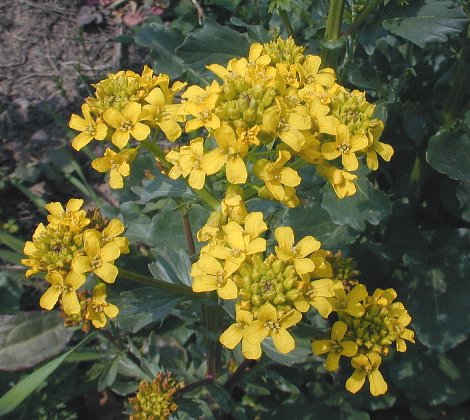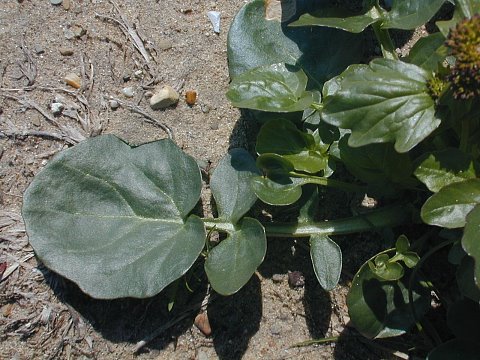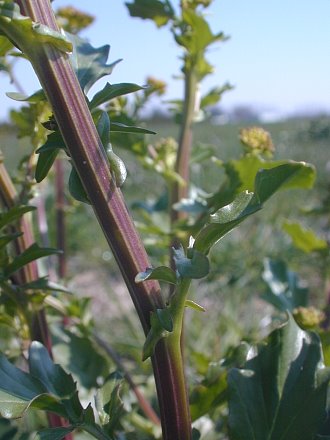Description: This herbaceous biennial plant is 1–2½' tall. During the first year it forms a rosette of basal leaves up to 1' across, while during the second year it bolts upward with one or more flowering stalks. These stalks are hairless, stout, light green to reddish purple, and somewhat angular. Secondary stalks are produced in the upper half of the plant. The basal leaves are up to 6" long and 2½" across. They are odd-pinnate with 1-4 pairs of lateral lobes and a terminal lobe that is larger than the others. These lobes are oval, obovate, or nearly orbicular, and they have margins that are slightly undulate or bluntly dentate. The alternate leaves are sessile or clasp the stems. The lower to middle alternate leaves resemble the basal leaves, except that they are smaller and have fewer lateral lobes. The upper alternate leaves are up to 2" long and 1" across; their margins are shallowly lobed, undulate, or bluntly dentate. Both the basal and alternate leaves are dark green, hairless, and shiny on the upper surface.

The upper stems terminate in racemes of yellow flowers. The flowers bloom toward the apex of each raceme, while the seedpods (siliques) develop below. Each flower is up to 1/3" (8 mm.) across, consisting of 4 yellow petals, 4 yellowish green sepals that are linear-lanceolate, 6 stamens with pale yellow to light brown anthers, and a single pistil with a thick style. A robust plant will produce these flowers in great abundance and they are mildly fragrant. The blooming period occurs from mid-spring to early summer and lasts about 1 month (peaking during late spring). Each flower is replaced by an angular-cylindrical seedpod about ¾-1" long. The base of each seedpod is connected to a short slender pedicel, while at the other end it terminates in a short slender beak. These seedpods are ascending, rather than strictly erect, along the racemes. The seeds are ovoid, slightly flattened, and more or less brown. The root system consists of a stout taproot. This plant spreads by reseeding itself, and it occasionally forms colonies.

Cultivation:
The
preference is full sun, moist to mesic conditions, and a fertile loam
or clay-loam soil. Growth is less robust at dry sites with poor soil. A
little shade is also tolerated. Most vegetative growth occurs during
the cool weather of early to mid-spring.
Range & Habitat:
The adventive Yellow Rocket is a common plant that occurs in most
counties of
Illinois (see Distribution
Map). It is native to Eurasia. Habitats include cropland,
fallow fields, vacant lots, construction sites, gardens, moist meadows,
areas along roadsides and railroads, and waste areas. Highly disturbed
areas are preferred; sometimes this species occurs in natural areas
that are slightly degraded (including prairie restorations), but it is
not particularly invasive.

Faunal Associations: The nectar and pollen of the flowers attract Andrenid bees, other small bees, and flies primarily. Occasionally, the Cabbage White (Pieris rapae) and other White butterflies can be observed sucking nectar from the flowers. The caterpillars of some butterflies and moths feed on the foliage or flowers, including Pontia protodice (Checkered White), Pieris rapae (Cabbage White), Anthocharis midea (Falcate Orangetip), Eustixia pupula (Pyralid Moth sp.), and Evergestis pallidata (Purple-Backed Cabbageworm). Several leaf beetles feed on Yellow Rocket: Microtheca ochroloma, Phaedon viridis, Phyllotreta bipustulata, Phyllotreta conjuncta, Phyllotreta cruciferae, Phyllotreta striolata, Phyllotreta zimmermanni, Psylliodes convexior, and Psylliodes punctulatus. Another insect that feeds on this plant is the stinkbug Holcostethus limbolarius. The seeds are a minor source of food to the Mourning Dove, while the foliage is eaten by cattle and sheep.

Photographic
Location:
A vacant lot in Urbana, Illinois.
Comments:
This plant is quite showy while it is in full bloom. The basal leaves
are reportedly edible during the early spring, but they later become
bitter. The Yellow Rocket that commonly occurs in Illinois is Barbarea vulgaris arcuata.
The typical variety of Yellow Rocket is rarely seen in Illinois; it
differs from var. arcuata by having erect seedpods
(siliques). A species with a similar appearance, Barbarea
verna (Early Winter Cress), occurs further to the east and is
rarely observed in Illinois. It differs from Yellow Rocket in having
basal leaves with 4-7 pairs of lateral lobes, while its alternate
leaves are more often pinnatifid. The seedpods of Early Winter Cress
are
longer than those of Yellow Rocket (at least 1¼" in length) and the
pedicels of its flowers are more stout.